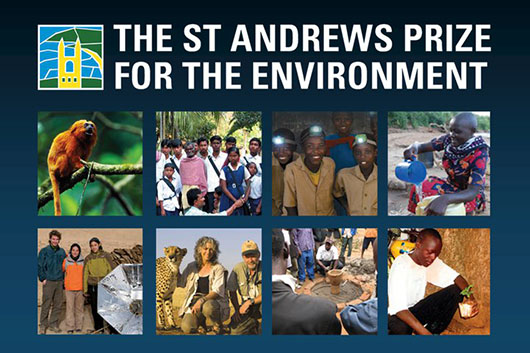Shortlist for £100,000 St Andrews Prize

New initiatives that could see bees used to protect African crops from elephants; a new desalination process providing millions around the globe with access to fresh drinking water; and technology transforming barren floodlands into fertile fields in Bangladesh – are to be recognised by the St Andrews Prize for the Environment.
The three finalists have been chosen for this year’s prestigious St Andrews Prize for the Environment Following receipt of 289 entries from 64 countries. The winner will receive $100,000 USD (£66,300 GBP) and the two runners-up will each receive $25,000 USD (£16,500 GBP).
Now in its fifteenth year the primary objective of the prize is to find innovative solutions to environmental challenges. The solutions should be combine good science, economic reality and political acceptability.
The projects have been selected by a distinguished panel of environmentalists, scientists and industrialists, led by Sir Crispin Tickell, author of the ground breaking book ‘Climate Change and World Affairs’.
Sir Crispin Tickell, Chairman of the St Andrews Prize for the Environment Trustees, said:
“Over the years, the Prize has gone from strength-to-strength and we are delighted that it continues to attract such a wide range of innovative and thought-provoking projects from such diverse backgrounds. We look forward to meeting this year’s three finalists in St Andrews next month to find out how their projects are seeking to make the world a better place by changing the lives of those around them.”
The finalists’ presentations will be heard at a seminar at St Andrews University and the winner will be announced at a ceremony on Friday, 3 May 2013.
This year’s finalists are:
Elephants and bees
This project has developed from the behavioural discovery that honey bees can be used as a natural deterrent for crop raiding elephants. In Kenya, elephants are not confined to national parks and reserves and crop raiding elephants can pose serious social, political, economic and conservation problems.
Elephants will actively avoid the threat of African honey bees and not only run away from bee sounds, but emit a low frequency rumble that warns other elephants in the area to retreat. This discovery led to the development and testing of protective beehive fences positioned around farmers’ fields with the aim of reducing human/elephant conflict.
The beehives are hung every 10 metres and linked together in a specific formation. If an elephant touches a hive or interconnecting wire, the hives all along the fence line swing and release the bees. In addition to fending off the elephants, the beehives provide optimum honey yields for the farmers.
Saltwater desalination by freezing
This project uses CryoDesalination, which is a saltwater desalination process by freezing. Compared with currently-used desalination technology, CryoDesalination is economical to build, environmentally friendly, and is highly energy efficient. The process could provide access to fresh water and improve the lives of millions of people worldwide.
In addition to providing water for human and agricultural needs, CryoDesalination can positively impact the environment by enabling the petroleum industry to be eco-friendly when desalinating the huge volumes of water that are by-products of exploration and production activities.
The freezing process works by using a natural phenomenon: ice made from saltwater is salt-free. Research into desalination by freezing has been undertaken since the 1950s, but a solution to a major obstacle – the separation of ice from brine on an industrial scale – has never been achieved. This project has solved the separation issue by using floatation. Ice is separated from brine by selecting an oil e.g. a corn oil that floats in between ice and brine, thereby enabling the harvesting of fresh water by melting the separated ice.
Transforming lands, transforming lives
This project demonstrates the use of the sandbar cropping technology in five districts in North West Bangladesh. Sandbar cropping is an innovative, simple and cost effective technology, which transforms lands that have become silted and barren by flooding. The project helps thousands of displaced and extremely poor families to escape from poverty and hunger.
The project has been designed to benefit some 32,000 households, whose villages and farms have been lost through river erosion across an area of over 9,000 square kilometres and who are forced to live on flood protection embankments.
The project transforms previously unproductive sandbars into profitable fields in which pumpkins are grown in small compost pits benefitting extremely poor families in the region.
Notes to News Editors
The Prize is a joint environmental initiative by the University of St Andrews in Scotland and exploration and production company ConocoPhillips, which aims to find practical solutions to environmental challenges from around the globe.
Find out all you need to know about the Prize at www.thestandrewsprize.com.
Category Awards